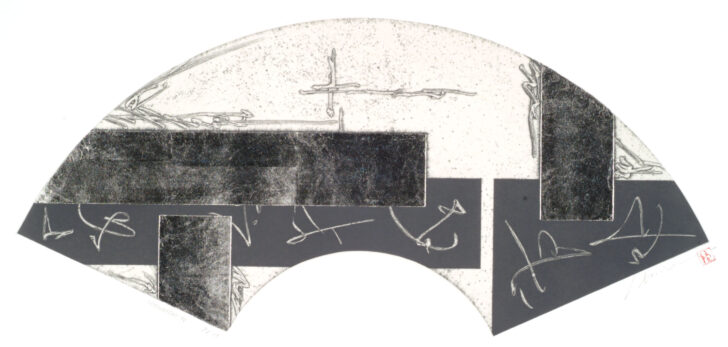Yatsuhashi IV
Nakazawa Shin'ichi

Description
Nakazawa Shin’ichi
Japan, born 1956
Yatsuhashi IV
Heisei period (1989–2019)
2002
Etching with platinum leaf on paper
Museum purchase made possible by Jane and Ken Lieberthal,
2003/1.388
Ise monogatari, or The Tales of Ise, is among the oldest literature
produced in Japan. Based on the life of the ninth-century poet
Ariwara no Narihira, it comprises nearly 150 poems, each introduced
by a short prose text. This striking contemporary print evokes one
of its most famous episodes, in which the protagonist and his fellow
travelers come to an iris-filled marsh crossed by a wood plank bridge
(yatsuhashi). Challenged to compose a poem using the syllables of the
word for iris— kakitsuhata in the older Japanese spelling—as the start
of each line, the protagonist recited:
Karagoromo The touch of my beloved wife—
Kitsutsu narenishi As familiar to my skin as the silk
Tsuma shi aredo Of a well-worn Chinese-style robe
Harubaru kinuru And so this distant journeying
Tabi wo shi zo omou. Fills my heart with longing.*
Nakazawa Shin’ichi evokes the highly abstract style of the Rimpa
School, indicating the marsh with splattered gray ink and the bridge
supports with just a few lines.
* Adapted from a translation by Helen Craig McCullough.
Summer 2022 Gallery Rotation
__________
Ise monogatari, or The Tales of Ise, is even older than The Tale of Genji. Based on the life of the ninth-century poet Ariwara no Narihira, Ise is a compilation of nearly 150 poems, each set in context by a short prose text. This striking contemporary print evokes one of the most famous episodes in The Tales of Ise, when the protagonist and some friends are traveling and come to an iris-filled marsh, crossed by an eight-fold plank bridge (yatsuhashi). Challenged to compose a poem using the word for iris— kakitsubata—as the first syllables of each line, the protagonist recited:
Karagoromo The touch of my beloved wife—
Kitsutsu narenishi As familiar to my skin as the silk
Tsuma shi aredo Of a well-worn Chinese-style robe
Harubaru kinuru And so this distant journeying
Tabi wo shi zo omou. Fills my heart with longing.*
* Adapted from a translation by Helen Craig McCullough.
The eight-fold bridge is such a well-known motif in Japanese artsthat it can immediately be recognized in this highly abstracted version by Nakazawa Shin’ichi. Nakazawa indicates the marsh with splattered gray ink on a cream ground, with only a few lines to suggest the wooden bridge supports. He has rendered the planks —only three are needed—in platinum foil, and their shadows in solid black, traced with the ghost of an ancient but unforgotten verse.
Maribeth Graybill, Senior Curator of Asian Art
Exhibited in "Stories from the Past: Narrative in Asian Art "
January 24–July 25, 2004
Usage Rights:
If you are interested in using an image for a publication, please visit https://umma.umich.edu/request-image/ for more information and to fill out the online Image Rights and Reproductions Request Form.